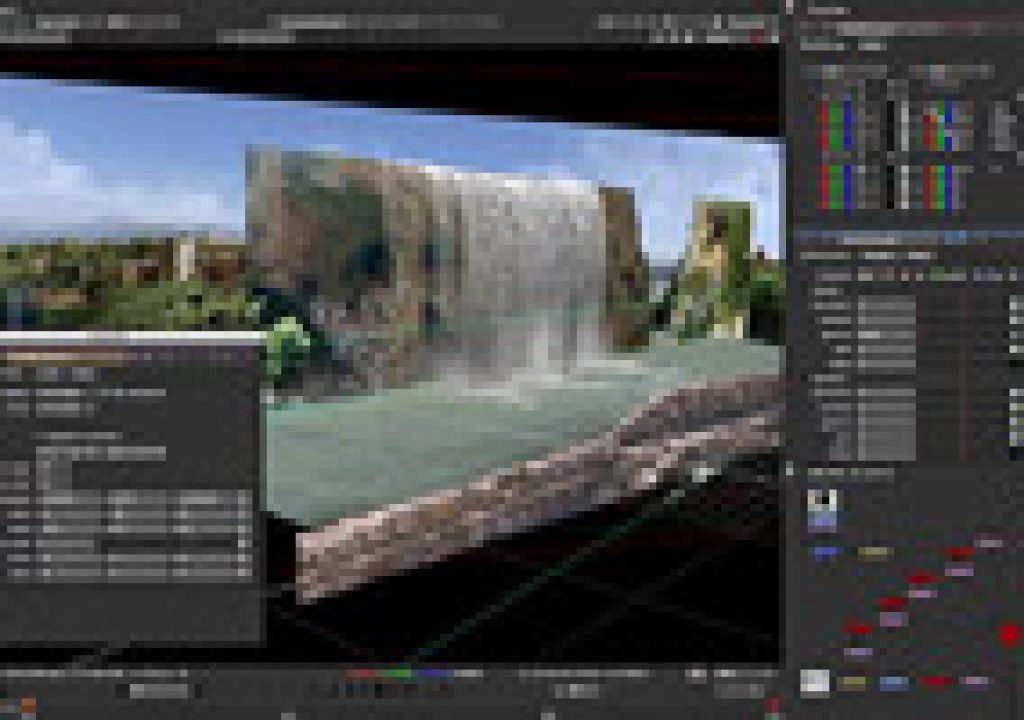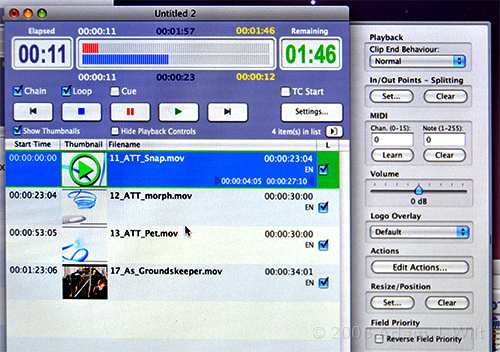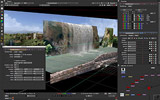
As expected, NAB 2008 did not reveal any major new software releases for motion graphic designers, but it did showcase a number of interesting new plug-ins. We’d like to give you a quick round-up of our favorites here; we’re arranging to give many of these more in-depth reviews up here on PVC over the next several months. We also were very interested in with what The Foundry has done with the high-end compositing application Nuke (which they acquired from Digital Domain), and came away with the impression that in this slow economy, training has become more important again.
Noise Industries FxFactory
 Perhaps most intriguing wasn’t a new plug-in, but a currently-existing set which is coming to the After Effects world. Noise Industries is better known to the Apple Final Cut Pro and Motion audience as creator of FxFactory Pro, a set of over 130 GPU-accelerated filters, generators, and transitions which take advantage of Apple’s Quartz Composer technology and their FxPlug specification. In addition to manipulating the parameters of these effects, you can modify their inner workings by editing their Quartz Composer plumbings to create your own effects. Once you’ve purchased the core FxFactory engine, you can then also buy add-on sets of effects offered by third parties which Noise Industries distributes. The core set normally retails for the rather reasonable price of $399; the NAB special price is $319 (valid through April 20). Add-on sets tend to run $50-100 – also very reasonable.
Perhaps most intriguing wasn’t a new plug-in, but a currently-existing set which is coming to the After Effects world. Noise Industries is better known to the Apple Final Cut Pro and Motion audience as creator of FxFactory Pro, a set of over 130 GPU-accelerated filters, generators, and transitions which take advantage of Apple’s Quartz Composer technology and their FxPlug specification. In addition to manipulating the parameters of these effects, you can modify their inner workings by editing their Quartz Composer plumbings to create your own effects. Once you’ve purchased the core FxFactory engine, you can then also buy add-on sets of effects offered by third parties which Noise Industries distributes. The core set normally retails for the rather reasonable price of $399; the NAB special price is $319 (valid through April 20). Add-on sets tend to run $50-100 – also very reasonable.
What piqued our ears was an announcement at the Media Motion Ball that they were porting FxFactory to Adobe After Effects. They are working on a shell which will allow FxPlug effects to run inside After Effects, which they expect to be ready in about two months. We’re very curious to try this out for ourselves, both to check out their effects and also to see what sort of performance penalty there will be running them inside of After Effects – hopefully not much. We talked to at least one other FxPlug effect manufacturer who indicated that if they worked, they would use it to port their own effects over to After Effects.
In the meantime, if you are already an FCP or Motion user, there is a 15-day free trial of FxFactory Pro available here.
DigiEffects Returns
One of the earliest plug-in manufacturers for After Effects was DigiEffects, perhaps best known for their Cinelook film treatment effect which pre-dated Magic Bullet and its brethren. The DigiEffects plug-ins were always interesting, but unfortunately also tended to be a tad slow and unstable.
Well, last year Robert Sharp took over DigiEffects and went about re-making the company. Cinelook is gone (although DigiEffects and Red Giant Software offer some very interesting crossgrade options to Magic Bullet), while many of the other core sets such as Delirium have been re-written. With their history tidied up, now they’ve started releasing new plug-in sets:
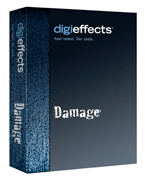
- Damage, which simulates several flavors of “bad TV” including a Blockade effect that recreates compression artifacts (apparently, there has been a big call from television post-production to make video appear as if it was shot by an eye witness with a cell phone).
- Two Natural Forces plug-in sets, including Vapor (Smoke, Smokescreen, Fog, and Nimbus cloud bank effects) and Aqua (Rain, Snow, Dispersion, Puddle, and Waterbeads effects). The sets cost $99 each.
- Two Simulate plug-in sets, including Illuma (Halo, Lightracer, Radiance, Photogust, and Luminus glow effects) and Camera (Archive, Overexpose, Iris, Destabilize, and Lens Flare effects). These sets also cost $99 each.
By the way, DigiEffects has also acquired the rights to the Walker Effects and Buena plug-in sets.
Digital Anarchy at Speed
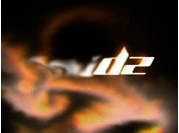 Speaking of natural forces, Digital Anarchy has licensed technology from SpeedSix Software Limited and announced a new FLUIDZ effect set for Adobe After Effects and Premiere Pro. FLUIDZ uses 2D fluid dynamic simulations to create fire, water, smoke, and vapor-based effects. We were particularly impressed by a pair of pre-rendered demos where fire followed a halftone grid of a woman dancing, reacting to the luminance values in the underlying footage, and making a logo disappear in a swirly fog.
Speaking of natural forces, Digital Anarchy has licensed technology from SpeedSix Software Limited and announced a new FLUIDZ effect set for Adobe After Effects and Premiere Pro. FLUIDZ uses 2D fluid dynamic simulations to create fire, water, smoke, and vapor-based effects. We were particularly impressed by a pair of pre-rendered demos where fire followed a halftone grid of a woman dancing, reacting to the luminance values in the underlying footage, and making a logo disappear in a swirly fog.
FLUIDZ is still a little ways off from shipping; we’ll report more complete impressions later after we’ve seen a more finished version of the plug-ins. In the meantime, click here to see some examples of what the technology can do running inside of Autodesk systems.
The Foundry’s Nuke 5.1
Last year, The Foundry – British purveyor of high-end effects for numerous editing, effects and graphics packages – acquired the high-end compositing application Nuke from Digital Domain. In February of this year, they released Nuke 5, which featured a new graphical user interface that has received praise from such demanding users as Stu Maschwitz of The Orphanage.
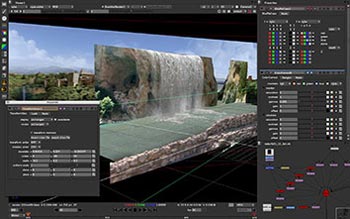 We went and checked out Nuke ourselves at NAB, and were deeply impressed at how well-integrated of a 3D environment it provided for what is actually a compositing rather than 3D application, including the import of .obj models and the ability to texture, shade, and projection map them. The 3D layer warp capability also had a fellow After Effects user drooling. This GPU-accelerated program also looked highly responsive on a Mac, a platform not known for having the best graphic performance out of your available options.
We went and checked out Nuke ourselves at NAB, and were deeply impressed at how well-integrated of a 3D environment it provided for what is actually a compositing rather than 3D application, including the import of .obj models and the ability to texture, shade, and projection map them. The 3D layer warp capability also had a fellow After Effects user drooling. This GPU-accelerated program also looked highly responsive on a Mac, a platform not known for having the best graphic performance out of your available options.
For those just as curious as we are, The Foundry was giving away a training DVD for Nuke, and also offers a 30-day trial which can be downloaded here. You can download a Fact Sheet (483 kB PDF) here, and the User Guide (13.93 MB PDF) here.
At $3500, Nuke is certainly more expensive than After Effects, but not outrageously so. It’s hardly a motion graphics tool – there are no 3D shadows, audio support, only basic type, et cetera – but it’s certainly a major player in the visual effects realm, especially with Apple Shake essentially frozen.
Are You Well Trained?
As mentioned in the lead-in, in this slow economy, it seems that many are turning to training as a way to survive or get ahead. Lynda.com (who we also create content for) is booming, far more self-described advanced users attended our sessions at Post|Production World this year than the previous two, and more and more companies are ramping up their own training materials (or creating entire training sites, such as Maxon US’s Cineversity).
 We picked up some “homework” from motion graphics designer John Dickinson of Motionworks in the form of three volumes of his Making It Look Great training series. The set is distributed by Zaxwerks as either DVD-ROMs or as “download only” projects. Hosts John, Alan Shisko, and Harry Frank step you through creating professional-quality projects using ProAnimator, 3D Invigorator, After Effects, Illustrator, and third-party plug-ins. We plan to review those soon up here on PVC when we come up for air!
We picked up some “homework” from motion graphics designer John Dickinson of Motionworks in the form of three volumes of his Making It Look Great training series. The set is distributed by Zaxwerks as either DVD-ROMs or as “download only” projects. Hosts John, Alan Shisko, and Harry Frank step you through creating professional-quality projects using ProAnimator, 3D Invigorator, After Effects, Illustrator, and third-party plug-ins. We plan to review those soon up here on PVC when we come up for air!
(Speaking of Zaxwerks, he also announced that a version of ProAnimator which will work in real time inside Final Cut Pro is almost ready to go…)
We didn’t get to see everything at NAB; for example, we missed Peder Norrby’s demo of his upcoming Trapcode Horizon plug-in which helps match camera moves to virtual backgrounds in After Effects, and only caught the tail-end of the Radium Glow demo in the Red Giant kiosk at the Plug-in Pavilion (in short, it consists of Glow EZ, a simple plug-in with limited controls, Glow with advanced controls and masking, Glow Edge for creating glows only on the edges of an image or around text, and Glow Depth which will create the Glow based on a secondary z-depth or depth buffer layer – due in a couple of months for $99). However, it was certainly enough to get the creative juices flowing again, and whet our appetite for trying out some new toys!
The content contained in our books, videos, blogs, and articles for other sites are all copyright Crish Design, except where otherwise attributed.

Filmtools
Filmmakers go-to destination for pre-production, production & post production equipment!
Shop Now